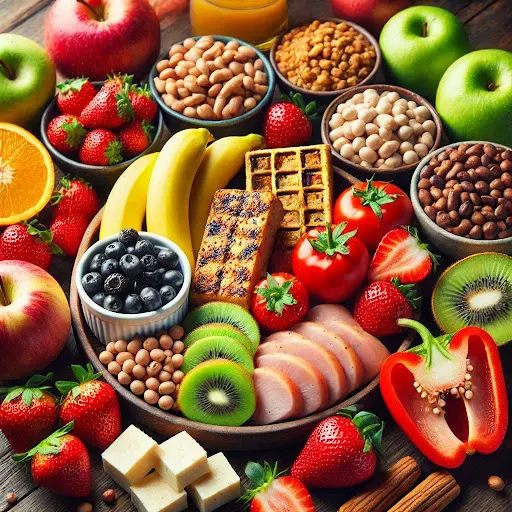Enjoy Fruits Without the Sugar Spike – Smart Tips and Tricks
📋 Table of Contents
Fruits are a delicious and essential part of a balanced diet, offering vitamins, fiber, and natural sweetness. However, some fruits can cause blood sugar spikes if consumed carelessly. Understanding the right choices and consumption methods can help you enjoy fruits without compromising your health.
Understanding Sugar Spikes in Fruits
Natural sugars in fruits, like fructose and glucose, can affect blood sugar levels. While they are healthier than processed sugars, excessive consumption can lead to spikes, especially for people with diabetes or insulin sensitivity.
The glycemic index (GI) is a measure of how quickly a food raises blood sugar levels. Fruits like watermelon and pineapple have high GI values, causing faster sugar spikes.
On the other hand, low-GI fruits such as berries, apples, and oranges release sugar more slowly into the bloodstream.
Understanding how your body reacts to specific fruits is key to managing sugar spikes effectively.
Factors such as ripeness and portion size also impact the sugar levels in fruits. Overripe fruits often contain more sugar.
Being mindful of these aspects can help you make informed choices and enjoy fruits without compromising your health.
Top Low-Sugar Fruits to Enjoy
Fruits with lower sugar content are excellent options for minimizing blood sugar spikes. Examples include:
- Berries (strawberries, blueberries, raspberries)
- Apples (preferably with the skin for added fiber)
- Citrus fruits like oranges and grapefruits
- Avocado, which is naturally low in sugar and high in healthy fats
Incorporating these fruits into your diet can provide sweetness without the risk of sugar overload.
Choosing seasonal and fresh options ensures maximum nutrients and taste.
Mastering Portion Control
Portion size plays a critical role in controlling blood sugar spikes. Eating too much fruit, even if it’s low-sugar, can still lead to issues.
A general guideline is to stick to one cup of fruit or a small handful for berries.
For larger fruits like apples or oranges, consider slicing them and consuming only half if needed.
Balancing fruit portions with vegetables or proteins in your meals can help slow down sugar absorption.
Remember that dried fruits, though nutrient-dense, are highly concentrated in sugar and should be consumed sparingly.
Pairing Fruits with Protein for Better Balance
Combining fruits with protein or healthy fats can reduce sugar spikes by slowing down digestion and sugar absorption.
Examples include pairing apple slices with almond butter or Greek yogurt with berries.
Cheese, nuts, and seeds are other excellent protein-rich options to accompany fruits.
This pairing not only stabilizes blood sugar but also provides a more satisfying snack or meal.
The Role of Fiber in Reducing Sugar Impact
Fiber slows down sugar absorption and helps maintain steady blood sugar levels. Fruits like pears, berries, and apples are high in fiber.
Consuming whole fruits, rather than juices, ensures you get the fiber intact.
Why Timing Matters When Eating Fruits
The timing of fruit consumption plays a significant role in managing sugar levels. Eating fruits earlier in the day allows your body to use the natural sugars as energy.
Consuming fruits alongside or after meals can slow down the release of sugar into the bloodstream.
For athletes or those engaging in physical activity, eating fruits before exercise can provide a quick energy boost.
Avoid consuming high-sugar fruits right before bedtime, as it might lead to sugar spikes and disrupt sleep quality.
By planning your fruit intake at appropriate times, you can maximize their benefits while minimizing sugar-related concerns.
Avoiding Processed Fruits and Hidden Sugars
Processed fruits, such as canned options or fruit snacks, often contain added sugars and preservatives, which can lead to sugar spikes.
Check labels carefully when purchasing dried fruits or packaged fruit juices, as they may contain hidden sugars or syrups.
Fresh, whole fruits are always the best choice for natural sweetness and nutrients.
If you opt for dried fruits, choose unsweetened options and consume them in moderation.
By steering clear of heavily processed fruits, you can maintain better control over your sugar intake and overall health.
❓ Frequently Asked Questions (FAQ)
Q: How can I reduce sugar spikes from fruits?
A: Pair fruits with protein or healthy fats, choose low-GI options, and consume them in moderation.
Q: Are smoothies a good way to consume fruits?
A: Smoothies can be healthy if made with whole fruits and no added sugars. Adding vegetables, protein, or fats can further balance sugar levels.
Q: Should I avoid high-sugar fruits like bananas?
A: High-sugar fruits like bananas are fine in moderation. Pair them with protein to slow sugar absorption.
Q: Is fruit juice a healthy option?
A: Whole fruits are healthier than fruit juice, as juice lacks fiber and often has concentrated sugars.
Q: What is the best time to eat fruits?
A: Morning or early afternoon is ideal. Avoid eating fruits late at night to prevent sugar spikes during rest.
Q: Are dried fruits healthy?
A: Dried fruits are nutrient-dense but should be consumed in moderation due to concentrated sugars.
Q: How does fiber in fruits affect blood sugar?
A: Fiber slows digestion and sugar absorption, reducing blood sugar spikes. Whole fruits are better than juices.
Q: Can I eat fruits while on a low-carb diet?
A: Yes, low-carb diets can include low-sugar fruits like berries, which are nutrient-rich and low in carbohydrates.







